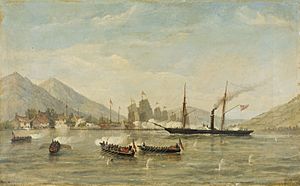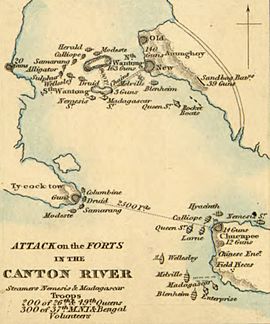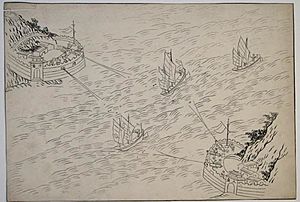Battle of the Bogue facts for kids
Quick facts for kids Battle of the Bogue |
|||||||
|---|---|---|---|---|---|---|---|
| Part of the First Opium War | |||||||
 The Nemesis attacking a masked battery and war junks behind Anunghoy Island on 23 February 1841 |
|||||||
|
|||||||
| Belligerents | |||||||
| Commanders and leaders | |||||||
| James Bremer | Guan Tianpei ☠ | ||||||
| Strength | |||||||
| 12 ships 1,037 men 3 guns1 |
30 junks 2,000 men1 506+ guns 3 forts |
||||||
| Casualties and losses | |||||||
| 5 wounded | 500+ killed or wounded 506 guns captured 3 forts captured |
||||||
| 1 In North Wangtong only. | |||||||
The Battle of the Bogue (Chinese: 虎門之戰) was a big fight between British and Chinese forces. It happened in China's Guangdong province, near the Pearl River Delta. The battle took place from February 23 to 26, 1841, during the First Opium War.
The British launched an attack from both land and sea at the Humen strait, also known as the Bogue. They captured important forts on the islands of Anunghoy and North Wangtong. This victory allowed the British fleet to sail further up the Pearl River. Their goal was to reach the city of Canton (Guangzhou), which they captured the next month.
Contents
Why the Battle Happened
After an earlier battle on January 7, 1841, British leader Charles Elliot and Chinese official Qishan tried to make a peace agreement. This agreement, called the Convention of Chuenpi, was signed on January 20. One of its main points was that the port of Canton would open for trade on February 2.
However, the port did not open as planned. On February 11 and 12, Elliot and Qishan met again. Elliot agreed to wait a bit longer for the treaty to be fully prepared. But the British started to suspect that the Chinese were getting ready for war instead.
On February 19, a British ship called the Nemesis returned without any good news. It had been sent to Canton to ask for the treaty to be approved. When the ship came under fire from a Chinese fort, it became clear that the Chinese were not going to sign the treaty.
Qishan then sent a message saying he would not sign and needed more time. But Elliot said they had tried hard enough to make peace. The British commander, James Bremer, sent several ships to stop the Chinese from building more defenses. In response, a Chinese official offered a large reward for the capture of Bremer or Elliot. This made the battle unavoidable.
The Battle Begins
On February 23, Captain Herbert and Elliot sailed to the back of Anunghoy Island. They were on the Nemesis with smaller boats. As they tried to get past large wooden stakes blocking the river, they found a hidden Chinese fort with 20 guns.
The fort immediately started firing. The Nemesis fired back with special cannonballs that spread out like shotgun pellets. The smaller British boats sailed towards the shore to attack the fort. Captain Herbert reported that 30 small Chinese boats quickly fled. The British landed and took over the fort very fast.
The Chinese soldiers ran away after a short fight. The British then burned the Chinese gunpowder storage areas and some boats. They also broke the 20 guns in the fort so they couldn't be used. They found 60 more guns and made them useless too. The British had no injuries, but 20 to 30 Chinese soldiers died.
On the same day, a Chinese official named Lin Zexu wrote in his diary. He mentioned that British ships had sailed up the river, fired, and burned some houses and a customs building.
Attacking Anunghoy Island
Since South Wangtong Island had no forts, the British built a cannon battery there. This battery would fire at the forts on North Wangtong Island. This also helped distract the Chinese from the main attack on Anunghoy.
On February 25, the Nemesis carried 130 Indian soldiers to the island. These soldiers helped set up a mortar battery, which fires shells high into the air. Engineers and artillery soldiers worked through the night to build a sandbag fort. They put three large cannons in place. The Chinese forts on North Wangtong fired at them, but most shots missed.
At dawn on February 26, the three cannons fired shells and rockets at North Wangtong and Anunghoy. British troops were ready to attack by 7:00 am. But because there was no wind, the ships couldn't move. The attack was delayed until 11:00 am when the wind picked up.
Anunghoy Island had three main forts: Weiyuan (42 guns), Jingyuan (60 guns), and Zhenyuan (40 guns). Captain Humphrey Fleming Senhouse led the attack on the southern fort. His ship, the Blenheim, and another ship, the Melville, fired many cannons at the fort.
A British officer wrote that their firing was "most splendid." The Chinese defenders quickly fled up the hills. By 1:20 pm, the British had fired so much that the forts were silent. Senhouse landed with about 300 soldiers and sailors to clear out any remaining defenders. By 1:30 pm, all three forts were captured.
Chinese Admiral Guan Tianpei was among the 250 Chinese soldiers killed or injured on Anunghoy. The next day, after his family found his body, the British ship Blenheim fired a special salute in his honor. A Chinese bell captured by Senhouse was later sent to England.
Taking North Wangtong Island
North Wangtong Island had two forts: Wangtong (on the east) and Yong'an (40 guns on the west). There was also a smaller defense with 17 guns. A large barrier made of chains and wooden rafts blocked the river between South Wangtong and South Anunghoy Fort. This barrier was not broken until after the forts were taken.
Commodore Bremer's ship, the Wellesley, and another ship, the Druid, attacked the southwest forts. Other British ships attacked the northwest and southeast forts. These forts had about 2,000 Chinese defenders. In less than an hour, the British cannons silenced the forts.
At 1:30 pm, over 1,000 British and Indian soldiers landed on the island. They came from ships like the Nemesis and Madagascar. Within minutes, the British captured the island. About 1,300 Chinese soldiers surrendered. Around 250 Chinese were killed or injured on Wangtong, and 167 guns were captured.
In total, only five British soldiers were injured that day. The British captured 339 cannons. Lin Zexu wrote in his diary that he heard the Bogue and Wangtong forts had fallen. He said he "could not sleep all night."



